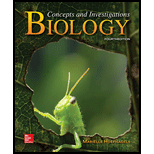
Introduction:
Thermoregulation is mechanism through which the body temperature is controlled. In this process, the heat gained from the environment, and lost to the environment is balanced by the body. This process is responsible for maintaining the homeostasis of the body.
Answer to Problem 1MCQ
Correct answer:
The animal whose body temperature would drop the fastest in a cold environment is a lizard. Therefore, option d. is correct.
Explanation of Solution
Reason for the correct statement:
The internal temperature regulating mechanism is not present in the ectotherms, and the temperature of the ectotherms depends upon the temperature of their surroundings. The majority of animals, including nonavian reptiles, amphibians, and all invertebrates are ectotherm. Lizards are the reptiles, which are also ectotherm and cannot regulate their internal body temperature.
Option d. is given as "A lizard".
As, “A lizard is an ectotherm which cannot regulate its internal temperature and changes its body temperature according to the environment”, is the right answer.
Hence, option d. is correct.
Reasons for the incorrect statements:
Option a. is given as “A whale”.
A whale is a mammal, which can regulate it internal body temperature. So, it is a wrong answer.
Option b. is given as “An Arctic bird”.
An arctic bird is an endotherm, which can regulate its internal body temperature. So, it is a wrong answer.
Option c. is given as “A tropical bird”.
A tropical bird has feathers, which help in retaining the body in the birds. So, it is a wrong answer.
Hence, options a., b. and c. are incorrect.
A lizard’s body temperature would drop the fastest in a cold environment.
Want to see more full solutions like this?
Chapter 33 Solutions
Biology: Concepts and Investigations
- For short answer questions, write your answers on the line provided. To the right is the mRNA codon table to use as needed throughout the exam. First letter U บบบ U CA UUCPhe UUA UCU Phe UCC UUG Leu CUU UAU. G U UAC TV UGCys UAA Stop UGA Stop A UAG Stop UGG Trp Ser UCA UCG CCU] 0 CUC CUA CCC CAC CAU His CGU CGC Leu Pro CCA CAA Gin CGA Arg CUG CCG CAG CGG AUU ACU AAU T AUC lle A 1 ACC Thr AUA ACA AUG Mot ACG AGG Arg GUU GCU GUC GCC G Val Ala GAC Asp GGU GGC GUA GUG GCA GCG GAA GGA Gly Glu GAGJ GGG AACASH AGU Ser AAA1 AAG Lys GAU AGA CAL CALUCAO CAO G Third letter 1. (+7) Use the table below to answer the questions; use the codon table above to assist you. The promoter sequence of DNA is on the LEFT. You do not need to fill in the entire table. Assume we are in the middle of a gene sequence (no need to find a start codon). DNA 1 DNA 2 mRNA tRNA Polypeptide C Val G C. T A C a. On which strand of DNA is the template strand (DNA 1 or 2)?_ b. On which side of the mRNA is the 5' end (left or…arrow_forward3. (6 pts) Fill in the boxes according to the directions on the right. Structure R-C R-COOH OH R-OH i R-CO-R' R R-PO4 R-CH3 C. 0 R' R-O-P-OH 1 OH H R-C-H R-N' I- H H R-NH₂ \H Name Propertiesarrow_forward4. (6 pts) Use the molecule below to answer these questions and identify the side chains and ends. Please use tidy boxes to indicate parts and write the letter labels within that box. a. How many monomer subunits are shown? b. Box a Polar but non-ionizable side chain and label P c. Box a Basic Polar side chain and label BP d. Box the carboxyl group at the end of the polypeptide and label with letter C (C-terminus) H H OHHO H H 0 HHO H-N-CC-N-C-C N-C-C-N-GC-OH I H-C-H CH2 CH2 CH2 H3C-C+H CH2 CH2 OH CH CH₂ C=O OH CH2 NH2arrow_forward
- please draw in what the steps are given. Thank you!arrow_forwardplease draw in and fill out the empty slots from image below. thank you!arrow_forwardThere is a species of eagle, which lives in a tropical forest in Brazil. The alula pattern of its wings is determined by a single autosomal gene with four alleles that exhibit an unknown hierarchy of dominance. Genetic testing shows that individuals 1-1, 11-4, 11-7, III-1, and III-4 are each homozygous. How many possible genotypes among checkered eagles in the population?arrow_forward
 Concepts of BiologyBiologyISBN:9781938168116Author:Samantha Fowler, Rebecca Roush, James WisePublisher:OpenStax College
Concepts of BiologyBiologyISBN:9781938168116Author:Samantha Fowler, Rebecca Roush, James WisePublisher:OpenStax College- Essentials Health Info Management Principles/Prac...Health & NutritionISBN:9780357191651Author:BowiePublisher:Cengage
 Biology (MindTap Course List)BiologyISBN:9781337392938Author:Eldra Solomon, Charles Martin, Diana W. Martin, Linda R. BergPublisher:Cengage Learning
Biology (MindTap Course List)BiologyISBN:9781337392938Author:Eldra Solomon, Charles Martin, Diana W. Martin, Linda R. BergPublisher:Cengage Learning





